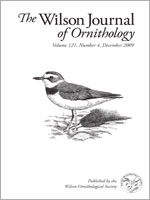We provide the first description of the nest, eggs, and nestlings of the Planalto Woodcreeper (Dendrocolaptes platyrostris), a secondary cavity-nester, based on three nests in natural cavities and 14 in nest boxes. Nests were found from October to January in 1997, 2006, and 2007 in the humid Chaco and Atlantic Forest of Argentina. Planalto Woodcreepers used natural cavities and nest boxes 40–60 cm deep with entrance diameters of 5–12 cm. They selected the deepest nest boxes available. Three or four white eggs were laid on a bed of bark flakes and incubated for 14–16 days. Newly hatched nestlings had pink skin with gray down, yellow mouth linings, and large whitish gape flanges. They opened their eyes when 6–7 days of age and fledged at 16–18 days. Nearly all nestlings were infested with botflies (Philornis sp.). Both adults contributed to nest building, incubation, nestling-rearing, and nest sanitation.
How to translate text using browser tools
1 December 2009
Nesting of the Planalto Woodcreeper (Dendrocolaptes platyrostris)
Kristina L. Cockle,
A. Alejandro Bodrati
ACCESS THE FULL ARTICLE





